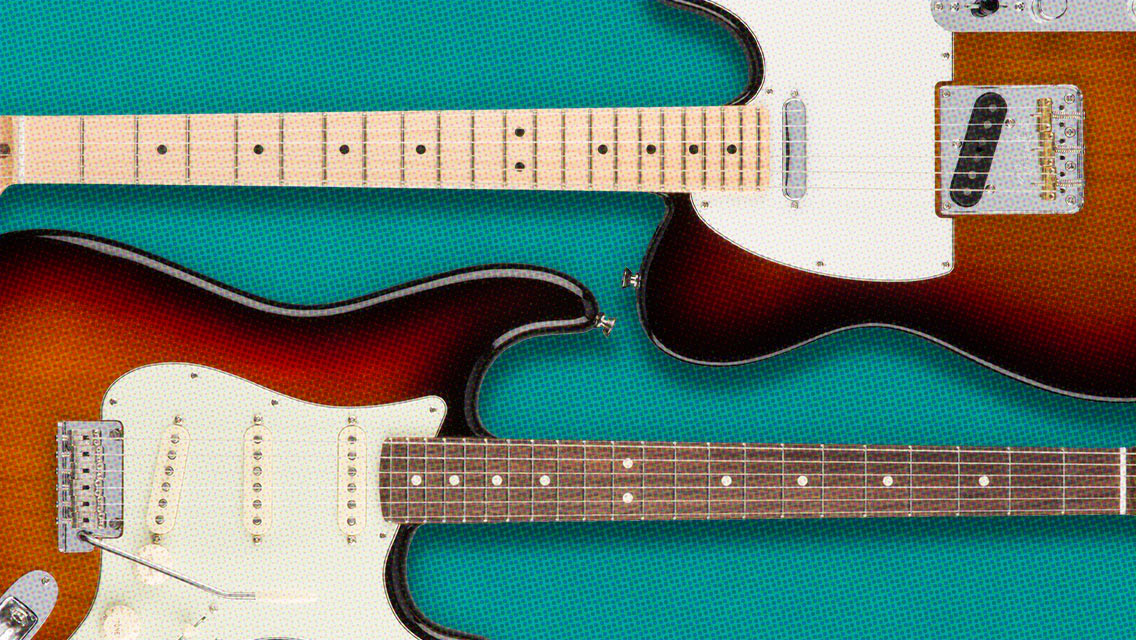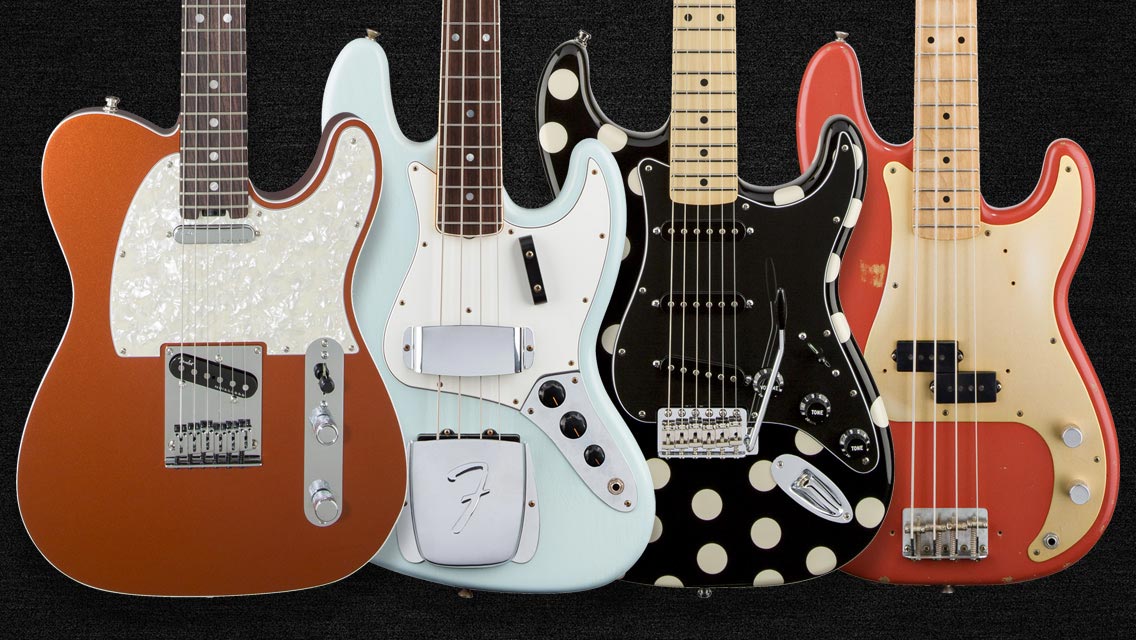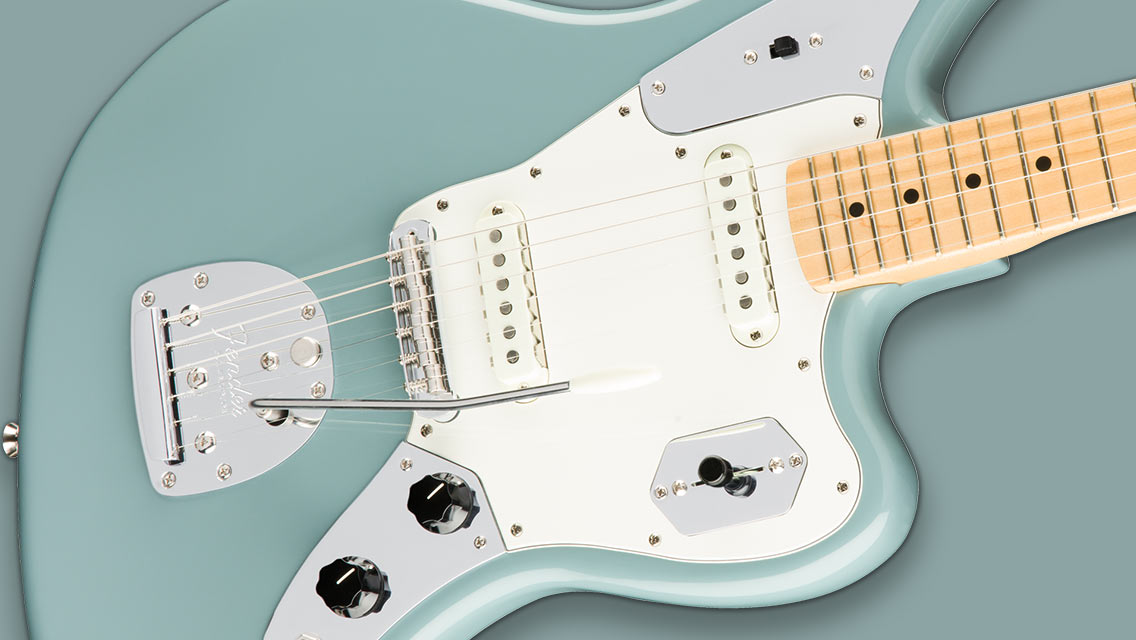2 Min ReadBy Ben Nemeroff
Teaching Kids Guitar
Teaching kids to play guitar often requires a “fun-focused” approach compared to adults! Learn tips and tricks for teaching guitar to kids with Fender.

Sections
Learning to play guitar at a young age can give kids a new appreciation for music and a creative outlet that they can use for the rest of their lives. Music itself is its own language. In fact, research has shown that children who learn to play an instrument helps develop the left side of the brain, which is involved with understanding language -- and even learning a second language. Teaching kids to play guitar or another instrument doesn’t just help them with language skills, but the rhythm and counting involved in learning to play can also enhance math skills. Additionally, learning an instrument helps children to develop listening skills and self esteem. Learning to play guitar can help a child feel more confident in their abilities as they get better and better over time. While learning to play can be a wonderful experience for kids, teaching a child to play guitar can differ somewhat from learning as an adult. From looking to smaller, kid-friendly guitars to the way you approach teaching a child and the songs they may want to learn, we’ll cover tips for teaching guitar to children and how to help make learning fun!
Tips for Teaching Guitar to Kids
If you’ve ever tried getting a kid to eat their vegetables or clean their room, you realize it can be an uphill struggle to get them to do something that may be good for them, but isn’t fun. When teaching young children guitar, it’s all the more reason to find ways to make it fun! Making learning to play guitar an enjoyable and fun experience can transform guitar lessons from something kids feel pressured to do into something they’re eager to keep practicing. Here are a few ways to make teaching young children guitar a fun and rewarding experience:
Be patient with kids and take small steps: Like learning new words and learning to walk or read, be patient with children who are just starting to play guitar. Break lessons down into small steps. Start with teaching them guitar basics like playing individual notes, finger placement, and learning to strum. Similarly, break practice sessions into shorter blocks instead of expecting a child to commit to a full hour of learning and practice. If they want to learn and play more, great! But it’s always best to leave them wanting to learn more and build better daily practice habits instead of one long session.
Put music on around the house on a regular basis to inspire them: For kids, the world is a place of endless exploration. The music you’ve heard a million times is brand new to them. Playing music around the house every day can help them develop their own tastes. It’s also a great springboard for conversation about the bands and artists you loved growing up. Listening to music can help to inspire kids to want to learn more and play guitar themselves.
Put the guitar in sight so they can remember to play and practice: You know the saying: “Out of sight, out of mind.” Keeping a guitar in a spot where a child can see it may inspire them to pick it up and practice more often.
Reward effort, not results and keep a growth mindset: Very few kids are going to become a virtuoso in just a few short practice sessions. Every guitarist was a beginner once. It’s only natural that kids may put their fingers on the wrong spot on the fretboard or feel frustrated if they can’t position their hands correctly to play a chord. That’s okay! Reassure them that, with time and practice, they’ll get better. Reward them for the simple act of picking up the guitar and trying. When a child doesn’t feel bad about not playing perfectly every time, they’ll be more encouraged to keep practicing -- and get better as a result!
At What Age Can Kids Learn Guitar?
The best age for a kid to start to learn to play guitar is typically between 6 and 10 years old. While it’s great to give your toddler a toy guitar to plunk away with, in order for them to really absorb lessons and build good technique, they’ll need to have developed fine motor skills, as well as the attention span required to learn to play guitar. Most kids don’t start preschool or kindergarten until around 4 or 5 years of age. Developing fine motor skills -- such as holding a pencil and learning to write their name, holding a spoon to eat cereal, and more -- are often part of the daily activities kids learn that become mechanical. If your child is still too young to have mastered learning to hold a pencil, it might be more difficult to teach young kids to play guitar. They may find it tough to wrap their tiny hands around even a kid-friendly guitar and maneuver them around the fretboard to produce notes and chords. It can be worth the wait to hold off until they’re at least six years old to start guitar lessons.
Learning to play guitar or any instrument can be a positive, rewarding experience for kids and can start them out on a musical journey that lasts a lifetime. The non-profit Fender Play Foundation is helping equip, educate, and inspire the next generation of players. Through a partnership with the LA Unified School District, the Fender Play Foundation is designing a sustainable model to increase access to music education. The Fender Play Foundation provides thousands of instruments, Fender Play accounts, and a curriculum taught by certified public school music teachers to foster a love of music and learning. The first step is getting instruments in the hands of young players. Even if a kid is too young to start learning to play guitar right now, stoking the fires of inspiration with this next generation of artists is a great way to keep them excited about and engaged with music until they’re old enough to start playing.
Don’t miss out!
Be the first to know about new products, featured content, exclusive offers and giveaways.
How to Teach a Kid to Play Guitar
One of the best ways to teach a kid to play guitar is to make it fun. If something is enjoyable, the greater the chances are of a child sticking with playing an instrument. Kids can get frustrated easily if something is forced on them. Start with easy exercises on the guitar to get them used to holding the guitar and learning where they can find different notes on the fretboard. If you’re teaching kids to play guitar, here are a few tips to make things fun and keep them engaged with learning more:
Choose the Right Guitar For Kids: The right instrument can make all the difference in the world when you’re trying to teach a little kid to play guitar. Kids with smaller hands might not be able to properly hold a full-sized guitar. Smaller-scale guitars, such as acoustic and electric guitars in ¾ sizes are among some of the best guitars for children who want to start playing. While even the largest ukulele is smaller than a ¾ sized guitar, it’s not always the right reason to recommend a child start learning to play ukulele when they want to learn guitar. While they are both stringed instruments, the ukulele and guitar sound distinctly different from each other. A child who may be drawn to the sound of an electric guitar may not want to play the soft, jangly chords of a ukulele -- and vice versa. While guitar is always a popular instrument with kids, there are plenty of lessons and songs kids can learn to play on ukulele too if they’d prefer to pick up a uke instead of a guitar. There are so many options of varying sizes for kids who want to learn to play guitar. Choosing the right sized instrument can go a long way toward motivating a child to keep practicing. And the best way to have a kid stick with learning to play is to let them learn to play the instrument they are most drawn toward.
Show Kids How to Hold a Guitar: Building good habits from a young age is essential to learning to play guitar. One of the first things to do when you’re trying to teach a kid how to play guitar is to show them how to hold it.
Sit in a comfortable chair without arms or on a stool. Don’t slouch!• Hold the neck of the guitar with your left hand, resting it in between your thumb and index finger.
Pull the back of the guitar towards your stomach, so it rests flat against you.
Rest the guitar on your thigh while seated. Pro tip: The curved section of the guitar’s body makes it ideal to hold it in place.• Grip a guitar pick in your right hand and gently drape your right arm over the strings near the sound hole (for an acoustic guitar) or pickups (on an electric guitar). Showing them how to hold a guitar and get in position to play notes on the fretboard and proper strumming technique is a great way to get kids comfortable playing.
Use Phrases to Learn Guitar String Names: It can be difficult for adults to remember the names of strings, let alone kids. One way to help kids remember the names of the strings is to use mnemonics -- phrases that are designed to jog their memory by relating words to specific letters. For example, the order of the strings from thickest to thinnest on the guitar are:• E• A• D• G• B• E That could be challenging for a child to remember when they’re learning to play guitar. Using fun phrases can help them remember guitar string names. For example:• Eat• All• Day• Get• Big• Easy Or • Elephants• And• Donkeys• Grow• Big• Ears Or • Eddie• Ate• Dynamite• Good• Bye• Eddie You get the idea! Make it fun and funny and chances are, a kid will never forget the names of their strings!
Research How to Teach a Child Guitar Chords: Learning to strum chords is one of the fundamental building blocks of a guitar education. For little kids, it may be challenging to play full chords that may require two or three fingers. Since their hands are smaller, it might be frustrating to try to play the full chord, only to have their fingers butt up against other strings and dampen the sound. One way to work around this when you’re teaching your child to play guitar is to show them how to play simple chords that are better suited to smaller hands. There are quite a few chord variations that only use one finger to play and can make it easy for kids to play. While these one-finger versions of a chord might not give you the full sound you’d hear as if you played them in their two- and three-finger incarnations, learning to play a modified version of a chord makes a kid feel like they’ve accomplished something big! It will likely be a less frustrating experience for them. Then, once they master the one-finger version, they can work their way up to learning the full chord in time. Two of the most popular chords that can be heard in a lot of songs are the G major chord and the C major chord. A fun way to get kids acquainted with what some of these chords sound like is to have them listen for them in some of their favorite songs. Kids can listen for both the G chord and C chord in songs like How Far I’ll Go from the movie Moana or Let it Go from the Frozen soundtrack. Check out how to play different variations of the G chord and the C chord on guitar, including one-finger versions:
Discover How Fender Play Can Help Your Child Learn Guitar
Learning to play guitar is an exciting adventure. Sign up for a free trial of Fender Play and get your child started learning chords, skills, and new songs on guitar. Fender Play can make it easy for kids to learn to play guitar and start building an appreciation for music at a young age, building skills and self-esteem along the way.


